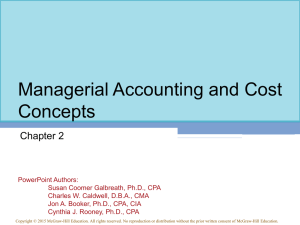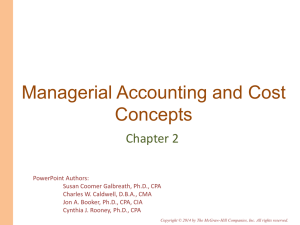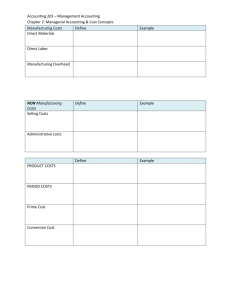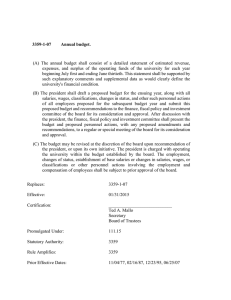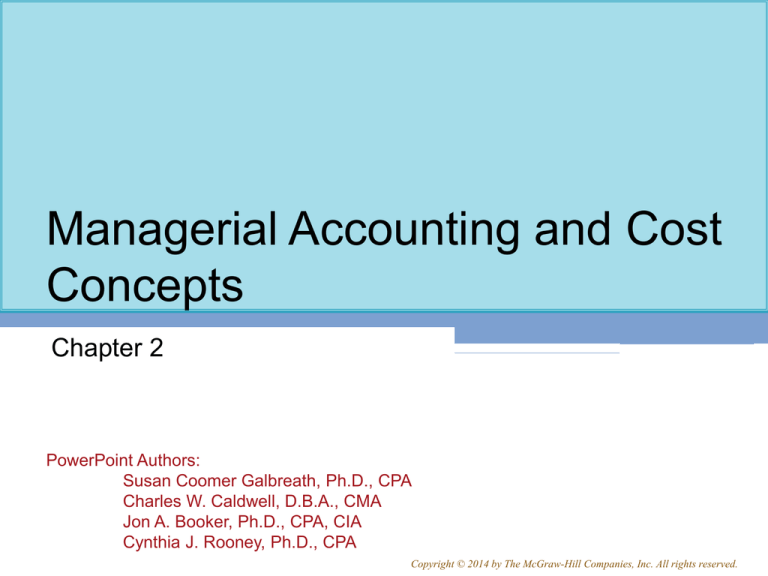
Managerial Accounting and Cost
Concepts
Chapter 2
PowerPoint Authors:
Susan Coomer Galbreath, Ph.D., CPA
Charles W. Caldwell, D.B.A., CMA
Jon A. Booker, Ph.D., CPA, CIA
Cynthia J. Rooney, Ph.D., CPA
Copyright © 2014 by The McGraw-Hill Companies, Inc. All rights reserved.
2-2
Summary of the Types of Cost
Classifications
Financial
Reporting
Predicting Cost
Behavior
Assigning Costs
to Cost Objects
Making Business
Decisions
2-3
Learning Objective 1
Understand cost
classifications used for
assigning costs to cost
objects: direct costs and
indirect costs. and indirect
costs.
2-4
Assigning Costs to Cost Objects
Direct costs
Indirect costs
• Costs that can be
easily and conveniently
traced to a unit of product
or other cost object.
• Costs that cannot be
easily and conveniently
traced to a unit of product
or other cost object.
• Examples: direct
material and direct labor
• Example: manufacturing
overhead
Common costs
Indirect costs incurred to support a number
of cost objects. These costs cannot be
traced to any individual cost object.
2-5
Learning Objective 2
Identify and give
examples of each of the
three basic
manufacturing cost
categories.
2-6
Classifications of Manufacturing Costs
Direct
Materials
Direct
Labor
The Product
Manufacturing
Overhead
2-7
Direct Materials
Raw materials that become an integral
part of the product and that can be
conveniently traced directly to it.
Example: A radio installed in an automobile
2-8
Direct Labor
Those labor costs that can be easily
traced to individual units of product.
Example: Wages paid to automobile assembly workers
2-9
Manufacturing Overhead
Manufacturing costs that cannot be easily
traced directly to specific units produced.
Examples: Indirect materials and indirect labor
Materials used to support
the production process.
Examples: lubricants and
cleaning supplies used in the
automobile assembly plant.
Wages paid to employees
who are not directly
involved in production
work.
Examples: maintenance
workers, janitors, and
security guards.
2-10
Nonmanufacturing Costs
Selling
Costs
Administrative
Costs
Costs necessary to secure the
order and deliver the product.
Selling costs can be either
direct or indirect costs.
All executive, organizational,
and clerical costs.
Administrative costs can be
either direct or indirect costs.
2-11
Learning Objective 3
Understand cost
classifications used to
prepare financial
statements: product
costs and period costs.
2-12
Cost Classifications for Preparing
Financial Statements
Product costs include
direct materials, direct
labor, and
manufacturing
overhead.
Cost of Good Sold
Inventory
Period costs include all
selling costs and
administrative costs.
Expense
Sale
Balance
Sheet
Income
Statement
Income
Statement
2-13
Quick Check
Which of the following costs would be
considered a period rather than a product cost
in a manufacturing company?
A. Manufacturing equipment depreciation.
B. Property taxes on corporate headquarters.
C. Direct materials costs.
D. Electrical costs to light the production
facility.
E. Sales commissions.
2-14
Quick Check
Which of the following costs would be
considered a period rather than a product cost
in a manufacturing company?
A. Manufacturing equipment depreciation.
B. Property taxes on corporate headquarters.
C. Direct materials costs.
D. Electrical costs to light the production
facility.
E. Sales commissions.
2-15
Prime Costs and Conversion Costs
Manufacturing costs are often
classified as follows:
Direct
Material
Direct
Labor
Prime
Cost
Manufacturing
Overhead
Conversion
Cost
2-16
Learning Objective 4
Understand cost
classifications used to
predict cost behavior:
variable costs, fixed
costs, and mixed costs.
2-17
Cost Classifications for Predicting Cost
Behavior
Cost behavior refers to
how a cost will react to
changes in the level of
activity. The most
common
classifications are:
▫ Variable costs.
▫ Fixed costs
▫ Mixed costs.
2-18
Variable Cost
Total Texting Bill
A cost that varies, in total, in direct proportion to
changes in the level of activity. Your total texting
bill may be based on how many texts you send.
Number of Texts Sent
2-19
Variable Cost Per Unit
Cost Per Text Sent
However, variable cost per unit is constant. The cost per
text sent may be constant at 5 cents per text message.
Number of Texts Sent
2-20
The Activity Base (Cost Driver)
Machine
hours
Units
produced
A measure of what
causes the
incurrence of a
variable cost
Miles
driven
Labor
hours
2-21
Fixed Cost
Monthly Cell Phone
Contract Fee
A cost that remains constant, in total, regardless of
changes in the level of the activity. Your monthly contract
fee for your cell phone may be fixed for the number of
monthly minutes in your contract.
Number of Minutes Used
Within Monthly Plan
2-22
Fixed Cost Per Unit
Monthly Cell Phone
Contract Fee
However, if expressed on a per unit basis, the average fixed cost per
unit varies inversely with changes in activity. The average fixed cost
per cell phone call made decreases as more calls are made.
Number of Minutes Used
Within Monthly Plan
2-23
Types of Fixed Costs
Committed
Discretionary
Long-term, cannot be
significantly reduced in
the short term.
May be altered in the
short-term by current
managerial decisions
Examples
Examples
Depreciation on Buildings
and Equipment and Real
Estate Taxes
Advertising and
Research and
Development
2-24
The Linearity Assumption and the
Relevant Range
Total Cost
Economist’s
Curvilinear Cost
Function
Relevant
Range
A straight line
closely
approximates a
curvilinear
variable cost
line within the
relevant range.
Accountant’s Straight-Line
Approximation (constant
unit variable cost)
Activity
2-25
Fixed Costs and the Relevant Range
The relevant range of activity pertains to fixed cost as
well as variable costs. For example, assume office space
is available at a rental rate of $30,000 per year in
increments of 1,000 square feet.
Fixed costs would increase
in a step fashion at a rate of
$30,000 for each additional
1,000 square feet.
2-26
Rent Cost in Thousands
of Dollars
Fixed Costs and the Relevant Range
90
Relevant
60
Range
30
0
0
The relevant range
of activity for a fixed
cost is the range of
activity over which
the graph of the
cost is flat.
1,000
2,000
3,000
Rented Area (Square Feet)
2-27
Cost Classifications for Predicting Cost
Behavior
Behavior of Cost (within the relevant range)
Cost
In Total
Per Unit
Variable
Total variable cost Increase
and decrease in proportion
to changes in the activity level.
Variable cost per unit
remains constant.
Fixed
Total fixed cost is not affected
by changes in the activity
level within the relevant range.
Fixed cost per unit decreases
as the activity level rises and
increases as the activity level falls.
2-28
Quick Check
Which of the following costs would be variable
with respect to the number of cones sold at a
Baskins & Robbins shop? (There may be more
than one correct answer.)
A. The cost of lighting the store.
B. The wages of the store manager.
C. The cost of ice cream.
D. The cost of napkins for customers.
2-29
Quick Check
Which of the following costs would be variable
with respect to the number of cones sold at a
Baskins & Robbins shop? (There may be more
than one correct answer.)
A. The cost of lighting the store.
B. The wages of the store manager.
C. The cost of ice cream.
D. The cost of napkins for customers.
2-30
Mixed Costs
A mixed cost contains both variable and fixed
elements. Consider the example of utility cost.
Total Utility Cost
Y
Variable
Cost per KW
X
Activity (Kilowatt Hours)
Fixed Monthly
Utility Charge
2-31
Mixed Costs
The total mixed cost line can be expressed
as an equation: Y = a + bX
Where:
Y
Y
a
Total Utility Cost
b
X
= The total mixed cost.
= The total fixed cost (the
vertical intercept of the line).
= The variable cost per unit of
activity (the slope of the line).
= The level of activity.
Variable
Cost per KW
X
Activity (Kilowatt Hours)
Fixed Monthly
Utility Charge
2-32
Mixed Costs – An Example
If your fixed monthly utility charge is $40, your
variable cost is $0.03 per kilowatt hour, and your
monthly activity level is 2,000 kilowatt hours, what is
the amount of your utility bill?
Y = a + bX
Y = $40 + ($0.03 × 2,000)
Y = $100
2-33
Analysis of Mixed Costs
Account Analysis and the Engineering Approach
In account analysis, each account is
classified as either variable or fixed based
on the analyst’s knowledge of how
the account behaves.
The engineering approach classifies
costs based upon an industrial
engineer’s evaluation of production
methods, and material, labor, and
overhead requirements.
2-34
Learning Objective 5
Analyze a mixed cost
using a scattergraph
plot and the high-low
method.
2-35
Scattergraph Plots – An Example
Assume the following hours of maintenance work
and the total maintenance costs for six months.
2-36
The Scattergraph Method
Plot the data points on a graph (Total Cost Y “dependent
variable” vs. Activity X “independent variable”).
Scattergraph Method
Y
Total Maintenance Cost
$10,000
$9,500
$9,000
$8,500
$8,000
$7,500
X
$7,000
400
500
600
700
Hours of Maintenance
800
900
2-37
The High-Low Method – An Example
The variable cost
per hour of
maintenance is
equal to the change
in cost divided by
the change in hours.
$2,400
= $6.00/hour
400
2-38
The High-Low Method – An Example
Total Fixed Cost = Total Cost – Total Variable Cost
Total Fixed Cost = $9,800 – ($6/hour × 850 hours)
Total Fixed Cost = $9,800 – $5,100
Total Fixed Cost = $4,700
2-39
The High-Low Method – An Example
The Cost Equation for Maintenance
Y = $4,700 + $6.00X
2-40
Quick Check
Sales salaries and commissions are $10,000
when 80,000 units are sold, and $14,000 when
120,000 units are sold. Using the high-low
method, what is the variable portion of sales
salaries and commission?
a. $0.08 per unit
b. $0.10 per unit
c. $0.12 per unit
d. $0.125 per unit
2-41
Quick Check
Sales salaries and commissions are $10,000
when 80,000 units are sold, and $14,000 when
120,000 units are sold. Using the high-low
method, what is the variable portion of sales
salaries and commission?
a. $0.08 per unit
Units
Cost
b. $0.10 per unit
High level
120,000
$ 14,000
c. $0.12 per unit
Low level
80,000
10,000
d. $0.125 per unit Change
40,000
$ 4,000
$4,000 ÷ 40,000 units
= $0.10 per unit
2-42
Quick Check
Sales salaries and commissions are $10,000
when 80,000 units are sold, and $14,000 when
120,000 units are sold. Using the high-low
method, what is the fixed portion of sales
salaries and commissions?
a. $ 2,000
b. $ 4,000
c. $10,000
d. $12,000
2-43
Quick Check
Sales salaries and commissions are $10,000
when 80,000 units are sold, and $14,000 when
120,000 units are sold. Using the high-low
method, what is the fixed portion of sales
salaries and commissions?
a. $ 2,000
Total cost = Total fixed cost +
Total variable cost
b. $ 4,000
$14,000 = Total fixed cost +
c. $10,000
($0.10 × 120,000 units)
d. $12,000
Total fixed cost
= $14,000 - $12,000
Total fixed cost
= $2,000
2-44
Least-Squares Regression Method
A method used to analyze mixed costs if a
scattergraph plot reveals an approximately linear
relationship between the X and Y variables.
This method uses all of the
data points to estimate
the fixed and variable
cost components of a
mixed cost. The goal of this method is
to fit a straight line to the
data that minimizes the
sum of the squared errors.
2-45
Least-Squares Regression Method
• Software can be used to fit a
regression line through the data
points.
• The cost analysis objective is the
same: Y = a + bX
Least-squares regression also provides a statistic,
called the R2, which is a measure of the goodness
of fit of the regression line to the data points.
2-46
Comparing Results From
the Two Methods
The two methods just discussed provide
different estimates of the fixed and variable cost
components of a mixed cost.
This is to be expected because each method
uses differing amounts of the data points to
provide estimates.
Least-squares regression provides the most
accurate estimate because it uses all the data
points.
2-47
Learning Objective 6
Prepare income
statements for a
merchandising company
using the traditional and
contribution formats.
2-48
The Traditional and Contribution
Formats
Used primarily for
external reporting.
Used primarily by
management.
2-49
Uses of the Contribution Format
The contribution income statement format is used
as an internal planning and decision-making tool.
We will use this approach for:
1.Cost-volume-profit analysis (Chapter 5).
2.Budgeting (Chapter 8).
3.Segmented reporting of profit data (Chapter 6).
4.Special decisions such as pricing and make-orbuy analysis (Chapter 12).
2-50
Learning Objective 7
Understand cost
classifications used in
making decisions:
differential costs,
opportunity costs, and
sunk costs.
2-51
Cost Classifications for Decision
Making
• Every decision involves a choice
between at least two
alternatives.
• Only those costs and benefits
that differ between alternatives
are relevant in a decision. All
other costs and benefits can and
should be ignored as irrelevant.
2-52
Differential Cost and Revenue
Costs and revenues that differ
among alternatives.
Example: You have a job paying $1,500 per month in
your hometown. You have a job offer in a neighboring
city that pays $2,000 per month. The commuting cost
to the city is $300 per month.
Differential revenue is:
$2,000 – $1,500 = $500
Differential cost is:
$300
2-53
Opportunity Cost
The potential benefit that is
given up when one alternative
is selected over another.
These costs are not
usually entered into the
accounting records or an
organization, but must be
explicitly considered in all
decisions.
What are the
opportunity costs you
incur to attend this class?
2-54
Sunk Costs
Sunk costs have already been incurred
and cannot be changed now or in the
future. These costs should be ignored
when making decisions.
Example: Suppose you had purchased gold for
$1,100 an ounce, but now it is selling for $950 an
ounce. Should you wait for the gold to reach $1,100
an ounce before selling it? You may say, “Yes” even
though the $1,100 purchase is a sunk costs.
2-55
Quick Check
Suppose you are trying to decide whether to
drive or take the train to Portland to attend a
concert. You have ample cash to do either, but
you don’t want to waste money needlessly. Is
the cost of the train ticket relevant in this
decision? In other words, should the cost of the
train ticket affect the decision of whether you
drive or take the train to Portland?
A. Yes, the cost of the train ticket is relevant.
B. No, the cost of the train ticket is not relevant.
2-56
Quick Check
Suppose you are trying to decide whether to
drive or take the train to Portland to attend a
concert. You have ample cash to do either, but
you don’t want to waste money needlessly. Is
the cost of the train ticket relevant in this
decision? In other words, should the cost of the
train ticket affect the decision of whether you
drive or take the train to Portland?
A. Yes, the cost of the train ticket is relevant.
B. No, the cost of the train ticket is not relevant.
2-57
Quick Check
Suppose you are trying to decide whether to
drive or take the train to Portland to attend a
concert. You have ample cash to do either, but
you don’t want to waste money needlessly. Is
the annual cost of licensing your car relevant in
this decision?
A. Yes, the licensing cost is relevant.
B. No, the licensing cost is not relevant.
2-58
Quick Check
Suppose you are trying to decide whether to
drive or take the train to Portland to attend a
concert. You have ample cash to do either, but
you don’t want to waste money needlessly. Is
the annual cost of licensing your car relevant in
this decision?
A. Yes, the licensing cost is relevant.
B. No, the licensing cost is not relevant.
2-59
Quick Check
Suppose that your car could be sold now for
$5,000. Is this a sunk cost?
A. Yes, it is a sunk cost.
B. No, it is not a sunk cost.
2-60
Quick Check
Suppose that your car could be sold now for
$5,000. Is this a sunk cost?
A. Yes, it is a sunk cost.
B. No, it is not a sunk cost.
2-61
End of Chapter 2

